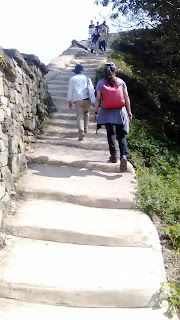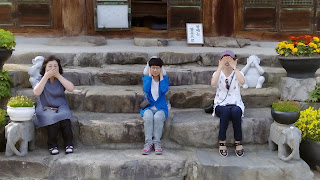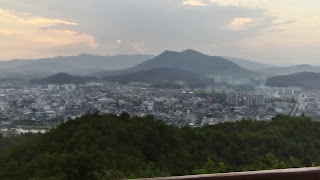Hi reader!
Thanks for visiting my blog.
If you’ve been following me, apologies for the overdue post.
Cheers for the commitment though.
In typical kiwi fashion, I’ll start with a note about the
weather. About a month ago now, summer’s overbearing heat ended abruptly and
autumn began. And it began dramatically, with heavy rain and strong wind. Now, the typhoon season is
behind us, although the rain has lingered, but I don’t mind (except for when it
defeats my outdoor plans). Anyway, seasons keep life interesting, and
everything and everyone seems to change and adapt around them.
The start of the new semester was met with a few challenges,
such as textbook changes, and a new Korean English teacher to cover for my
usual co-teacher’s maternity leave. Both have worked out really well – the textbooks
giving me more freedom with the curriculum, and the teacher’s support and
helpfulness has been great.
Overall, I feel much more comfortable, involved and
connected with life here at school. It takes a shift in perspective and
understanding when communicating and negotiating with Korean culture, and I
still make assumptions that I’ll be understood without fully considering the
cultural shift. A few weeks ago, for example, I showed my middle one class (of
three students) a picture of the Mona Lisa holding a cat, to elicit the
language we were learning. The first thing they commented on, however, was not
the cat, but the fact that her ‘eyebrows are strange!’ Facial features are very
important in Korean society.
Older bro Sam came to visit a couple of weeks into the
semester. The weather was a mixed bag, but we were able to get out and about a
fair bit over his short stopover here. We visited the home of a doctor friend
of mine, whose clinic is in Sanseo, near the school. I’ve got to know him and
his family well since my first day at the school, and it was great to introduce
Sam (also a doctor) for a medical chinwag. It was great to catch up with Sam
and show him my slice of life here in Korea.
In early September, I started attending the English worship
service at Jungbu church in Jeonju. I’m now used to the hour-long bus ride each
week, and I always bring my Korean textbook on the bus to pass the time. I feel
a strong sense of belonging to the community there, and the services and
fellowship are great. Because the congregation is made up almost entirely of fellow
expats, and because there are always new faces, the church has a strong sense
of transformation and moving forward.
In mid-September, the entire country braced itself for
Chuseok – Korean Thanksgiving. Chuseok is a time for families to come together,
but it couldn’t be more different from the relaxed family traditions of a Kiwi Christmas.
Korean families have a number of formalities that they have to undertake, which
causes quite a lot of stress, and greatly increases the traffic on the roads.
On Chuseok, families visit ancestral graves and home towns, which are often way
out in the countryside. I was very fortunate to be invited to another teacher’s
home, and as fascinating and enjoyable as it was (and as good as the food was),
it was slightly overwhelming to meet so many extended family members, who would
arrive in family groups, sit down for an hour for a quick meal, and then
continue on their way for further Chuseok events. Phew!
A couple of weeks later, I visited the town of Gochang with
my teacher’s class at school to see the extensive fortress wall used for
hundreds of years to repel Japanese invasions. We feasted our eyes on the
fields of red spider lilies, and feasted our bellies on grilled eel. Yum!
One rainy day at the very end of September, I reunited, for
the first time since February, with my fellow English teachers from orientation
who’d also been assigned across Jeollabuk-do province. We piled into a bus
bound for the southern coastal city of Suncheon. It rained heavily all day, but
I didn’t mind, as there was a lot of catching up to do! Hopefully we’ll all
meet again soon. We’ve all come so far! Unfortunately, I left my credit card in
a café in the Suncheon Bay National Garden (which, by the way, was spectacular, with showcases from around the world –
but no NZ section!), so I returned the next day for Suncheon, round two!
The following weekend, I journeyed to Seoul for the second
time since my arrival in Korea. Along with another teacher from school, we
visited Yanghwajin cemetery, in which are buried many of the earliest
protestant missionaries to Korea. I learnt so much about the dedication and
sacrifice of the missionaries, and their role in transforming Korea. Their
names live on in the hospitals, schools, and universities they left behind,
some of which we visited.
Teaching-wise, the following couple of weeks were very
fulfilling, but stress and tiredness soon crept back into school as the
mid-term exam week loomed ever closer. This has been a particularly difficult
time for the final-year high school students, where every point matters for
university entrance. The exams happened last week, and regardless of how they
went, the students were well and truly glad to be done. As a reward, some of
the teachers and the students went on a trip to Jeongeup, where we visited the
Gujeolcho (Siberian Chrysanthemum) gardens. The scenery was spectacular, and
the day concluded by a general overstuffing of Jajang noodles, rice and
Jjamppong.
And that bring me to now. I’m in the midst of another
full-on week at school, but it’s great to be back in the swing of things after
exams. Just as a couple of English teachers, and good friends, left Namwon, so
have two more arrived, and so it’s always nice to meet other foreigners (Kiwis
are a bit thin on the ground, though!). All in all, I feel like I’m becoming
more and more connected here – growing, learning, and strengthening. I’ve certainly come
a long way since day one!
Sorry for waffling on. I could’ve spun a few more yarns,
like the time I was shown around Gwangju by a total stranger (a Korean guy),
but I can sense you’re starting to fall asleep now…
Peace,
Nic.
 |
| Goodbye, teacher! After Summer camp. |
 |
| A visit to Gwangju 5.18 Memorial Park, which commemorates the Gwangju Democratisation Movement (or Gwangju Uprising), which started on the 18th of May, 1980. About 600 people, mostly students, were killed in the movement. Today, May 18th is a national holiday, and Gwangju is still proudly, and staunchly, a democratic city. |
 |
| In late August, I went to watch the Sanseo school orchestra perform in a regional concert in Jeonju. While our school has little over 70 students in total, the other schools represented at the event have 800 and over. Two weeks later, they went to the national competition in Busan. I'm so proud of our students from a little wee country school! |
 |
| The county in which I work - Jangsu - is famous for apples and beef. |
 |
| At the Asia Culture Centre in Gwangju. It was very cool to see this exhibit from ST PAUL St Gallery in Auckland. They also had Avalanche City playing in another part of the centre - odd! |
 |
| Very nice painting of Gould. |
 |
| Teacher's trip to Gochang (Gochangeupseong/Gochang fortress) |
 |
| Red spider lilies in Gochang. |
 |
| The homestead of Horace Underwood on the campus of Yonsei University, Seoul. Underwood was one of the most important protestant missionaries, and his grave is at Yanghwajin. |
 |
| The fellow himself. |
 |
| Seodaemun prison, opened after the collapse of the Joseon dynasty as Japan took control of the country in the early 20th century. Countless Koreans who threatened the Japanese rule were sent here. Of those imprisoned, most were severely tortured, and many died. |
 |
| Yoo Gwansoon was the youngest prisoner in Seodaemun. She was still a high school student when she was arrested, and was severely tortured and eventually died in the prison. She is remembered as a hero during the independence movement. |
 |
| Seoul at night, from Namsan tower. |
 |
| A trip with Namwon Church, which I attend for the monthly English service, to Yeosu. Spot the white guy at the back! |
 |
| Jeongeup Gujeolcho theme park. |















































